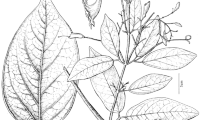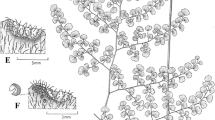Abstract
Both of the two main generic features ofOryctina (Loranthaceae), i.e., its dioeciousness and its absence of floral bracteoles, are based on misinterpretations. Instead, both species appear to be monoecious, and both are bracteolate. Nevertheless,Oryctina should be maintained as a distinct genus, probably most closely related toMaracanthus.
Similar content being viewed by others
Literature Cited
Eichler, A. W., 1868:Loranthaceae. — InMartius, C. F. P. v.: Flora Brasiliensis5 (2), 87–92, Tab. 30.
Kuijt, Job, 1961: Notes on the anatomy of the genusOryctanthus (Loranthaceae). — Can. J. Bot.39, 1809–1816.
—, 1976a: Revision of the genusOryctanthus (Loranthaceae). — Bot. Jahrb.95, 478–534.
—, 1976b:Maracanthus, a new genus ofLoranthaceae. — Brittonia28, 231–238.
Rizzini, C. T., 1977: Validation and redescription ofOryctina (Loranthaceae). — Plant Syst. Evol.128, 47–52.
Tieghem, P. van, 1895: Sur le genre nouveauOryctina. — Bull. Soc. Bot. France42, 168–169.
Author information
Authors and Affiliations
Rights and permissions
About this article
Cite this article
Kuijt, J. A rejoinder onOryctina (Loranthaceae). Pl Syst Evol 137, 215–219 (1981). https://doi.org/10.1007/BF00989875
Received:
Issue Date:
DOI: https://doi.org/10.1007/BF00989875




